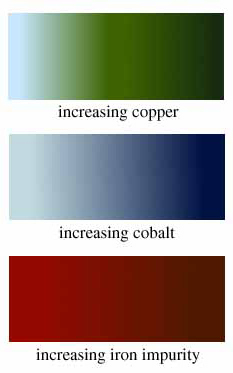- Glass Making in Roman Times
- Roman Wine: A Window on an Ancient Economy
- Roman Wine: Windows on a Lifestyle
- Fine Glassware in the Roman World
- Reuse of Images in the Art of Rogier van der Weyden
Blue, Green, and Opaque Red

The addition of specific coloring agents allows the hue of glass to be altered a great deal. The intensity of natural aquablue and green in a vessel is increased by the addition of copper, in some form, and an oxidizing atmosphere in the furnace. An aquablue gives way to a dark green as the amount of copper (as azurite, chalcopyrite, or scrap bronze) increases from 2% to 13%.
A dark royal blue is obtained using a copper mineral contaminated by cobalt. The presence of as little as 0.1% cobalt can cause intense coloration of glass. Other impurities that occur in cobalt ores, e.g. manganese, iron, and nickel, will darken the blue even further.
Opaque red glass is formed in the same way, but by the use of a reducing atmosphere in the furnace. The copper is precipitated out as minute, needle-like crystals of cuprous oxide. If the copper content is above 10%, these crystals scatter through a colorless matrix and give the appearance of a bright, blood-red glass. If some of the copper additive is still dissolved in the glass, however, a muddy brown coloration results.
